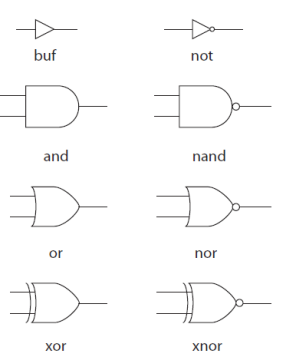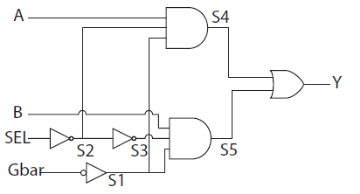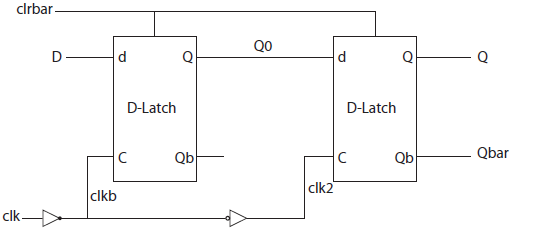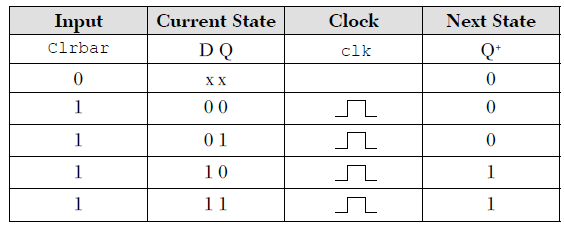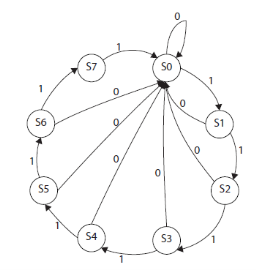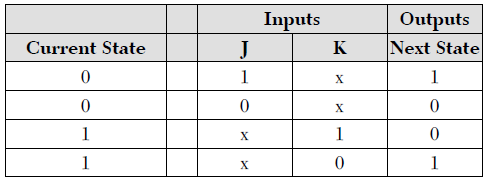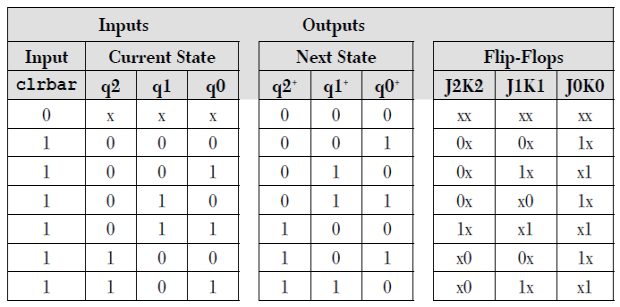|
VHDL Description library IEEE; use IEEE.STD_LOGIC_1164.ALL; entity xor2 is port(I1, I2 : in std_logic; O1 : out std_logic); end xor2; architecture Xor2_0 of xor2 is begin O1 <= I1 xor I2; end Xor2_0; library IEEE; use IEEE.STD_LOGIC_1164.ALL; entity and2 is port (I1, I2 : in std_logic; O1 : out std_logic); end and2; architecture and2_0 of and2 is begin O1 <= I1 and I2; end and2_0; library IEEE; use IEEE.STD_LOGIC_1164.ALL; entity half_add is port (a, b : in std_logic; S, C : out std_logic); end half_add; architecture HA_str of half_add is component xor2 port (I1, I2 : in std_logic; O1 : out std_logic); end component; component and2 port (I1, I2 : in std_logic; O1 : out std_logic); end component; begin X1 : xor2 port map (a, b, S); A1 : and2 port map (a, b, C); end HA_str; |
Example: Binding Between Entity and Architecture in VHDL entity one is port (I1, I2 : in std_logic; O1 : out std_logic); end one; architecture A of one is signal s : std_logic; .......... end A; architecture B of one is signal x : std_logic; ....... end B; Architecture A is bound to entity one through the predefined word of. Also, architecture B is bound to entity one through the predefined word of. Accordingly, I1, I2, and O1 can be used in both architecture A and architecture B. Architecture A is not bound to architecture B, so signal s is not recognized in architecture B. Likewise, signal x is not recognized in architecture A.
|
entity orgate is port (I1, I2 : in std_logic; O1 : out std_logic); end orgate; architecture Or_dataflow of orgate is begin O1 <= I1 or I2; end Or_dataflow; entity system is port (x, y, z : in std_logic; out r : std_logic_vector (3 downto 0); end system; architecture system_str of system is component orgate port (I1, I2 : in std_logic; O1 : std_logic); end component; begin orgate port map (x, y, r(0)); ....... end system_str; The component orgate is bound to the entity orgate because it has the same name. Architecture Or_dataflow is bound to entity orgate by the word of. All information in the entity is now visible to the component. Accordingly, the relationship between I1, I2, and O1 defined in the architecture or_dataflow is visible to the component orgate; hence, the component orgate is an OR gate. Now consider another way of VHDL binding where a library or a package is bound to a module.
|
library IEEE; use IEEE.STD_LOGIC_1164.ALL; entity system is port (I1, I2 : in std_logic; O1 : out std_logic_vector (3 downto 0)); end system; architecture lib_bound of system is signal s : std_logic; ............. end lib_bound; IEEE is the name of the library, library and use are a predefined words, and IEEE.STD_LOGIC_1164.ALL refers to the part of the library to be linked. Library IEEE gives the definition for the standard_logic type. By entering the name of the library and the statement use, all information in the library is visible to the module. If the first two statements are absent, the standard_logic type cannot be identified. Libraries can also be created by the user. The HDL simulator creates a library named work every time it compiles code. This library can be bound to another module by using the statement use, as follows: use entity work.gates (or_gates);
|
--First, write the code that will be bound to another -- module library IEEE; use IEEE.STD_LOGIC_1164.ALL; entity bind2 is port (I1, I2 : in std_logic; O1 : out std_logic); end bind2; architecture xor2_0 of bind2 is begin O1 <= I1 xor I2; end xor2_0; architecture and2_0 of bind2 is begin O1 <= I1 and I2; end and2_0; architecture and2_4 of bind2 is begin O1 <= I1 and I2 after 4 ns; end and2_4; --After writing the above code; compile it and store it -- in a known location. Now, open another module --where the above information is to be used. library IEEE; use IEEE.STD_LOGIC_1164.ALL; entity half_add is port (a, b : in std_logic; S, C : out std_logic); end half_add; architecture HA_str of half_add is component xor2 port (I1, I2 : in std_logic; O1 : out std_logic); end component; component and2 port (I1, I2 : in std_logic; O1 : out std_logic); end component; for all : xor2 use entity work.bind2 (xor2_0); for all : and2 use entity work.bind2 (and2_4); begin X1 : xor2 port map (a, b, S); A1 : and2 port map (a, b, C); end HA_str; The statement for all : xor2 use entity work.bind2 (xor2_0) binds the architecture xor2_0 of the entity bind2 to the component xor2. By this binding, component xor2 behaves as a two-input XOR gate with zero propagation delay. The statement for all : and2 use entity work.bind2 (and2_4) binds the architecture and2_4 of the entity bind2 to the component and2. By this binding, component and2 behaves as a two-input AND gate with a 4-ns propagation delay.
|
module one (O1, O2, a, b); input [1:0] a; input [1:0] b; output [1:0] O1, O2; two M0 (O1[0], O2[0], a[0], b[0]); two M1 (O1[1], O2[1], a[1], b[1]); endmodule module two (s1, s2, a1, b1); input a1; input b1; output s1, s2; xor (s1, a1, b1); and (s2, a1, b1); endmodule The statement: two M0 (O1[0], O2[0], a[0], b[0]); written in module one binds module two to module one. O1[0] is the output of a two-input XOR gate with a[0] and b[0] as the inputs O2[1] is the output of a two-input AND gate with a[1] and b[1] as the inputs
|
VHDL Description library IEEE; use IEEE.STD_LOGIC_1164.ALL; entity mux2x1 is port (A, B, SEL, Gbar : in std_logic; Y : out std_logic); end mux2x1; architecture mux_str of mux2x1 is --Start components Declaration component and3 port (I1, I2, I3 : in std_logic; O1 : out std_logic); end component; --Only different types of components need be declared. --Since the multiplexer has two identical AND gates, --only one is declared. component or2 port (I1, I2 : in std_logic; O1 : out std_logic); end component; component Inv port (I1 : in std_logic; O1 : out std_logic); end component; signal S1, S2, S3, S4, S5 : std_logic; for all : and3 use entity work.bind3 (and3_7); for all : Inv use entity work.bind1 (inv_7); for Or1 : or2 use entity work.bind2 (or2_7); begin --Start instantiation A1 : and3 port map (A,S2, S1, S4); A2 : and3 port map (B,S3, S1, S5); IV1 : Inv port map (SEL, S2); IV2 : Inv port map (Gbar, S1); IV3 : Inv port map (S2, S3); or1 : or2 port map (S4, S5, Y); end mux_str;
Verilog Description module mux2x1 (A, B, SEL, Gbar, Y); input A, B, SEL, Gbar; output Y; and #7 (S4, A, S2, S1); or #7 (Y, S4, S5); and #7 (S5, B, S3, S1); not #7 (S2, SEL); not #7 (S3, S2); not #7 (S1, Gbar); endmodule |
entity bind2 is port (I1, I2 : in std_logic; O1 : out std_logic); end bind2; ........... --Add the following architecture to --the entity bind2 of Listing 4.8 architecture bufif1 of bind2 is begin buf : process (I1, I2) variable tem : std_logic; begin if (I2 =’1’) then tem := I1; else tem := ‘Z’; end if; O1 <= tem; end process buf; end bufif1;
|
VHDL Description
library IEEE; use IEEE.STD_LOGIC_1164.ALL; entity bind22 is Port (I1, I2 : in std_logic; O1, O2 : out std_logic); end bind22; architecture HA of bind22 is component xor2 port (I1, I2 : in std_logic; O1 : out std_logic); end component; component and2 port (I1, I2 : in std_logic; O1 : out std_logic); end component; VHDL Description library IEEE; use IEEE.STD_LOGIC_1164.ALL; entity FULL_ADDER is Port (x, y, cin : in std_logic; sum, carry : out std_logic); end FULL_ADDER; architecture full_add of FULL_ADDER is component HA Port (I1, I2 : in std_logic; O1, O2 : out std_logic); end component; component or2 Port (I1, I2 : in std_logic; O1 : out std_logic); end component; for all : HA use entity work.bind22 (HA); for all : or2 use entity work.bind2 (or2_0); signal s0, c0, c1 : std_logic; begin HA1 : HA port map (y, cin, s0, c0); HA2 : HA port map (x, s0, sum, c1); r1 : or2 port map (c0, c1, carry); end full_add; Verilog Description module FULL_ADDER (x, y, cin, sum, carry); input x, y, cin; output sum, carry; HA H1 (y, cin, s0, c0); HA H2 (x, s0, sum, c1); //The above two statements bind module HA //to the present module FULL_ADDER or (carry, c0, c1); endmodule module HA (a, b, s, c); input a, b; output s, c; xor (s, a, b); and (c, a, b); endmodule |
VHDL Description library IEEE; use IEEE.STD_LOGIC_1164.ALL; entity SR_latch is port (R, S : in std_logic; Q, Qbar : buffer std_logic); --Q, Qbar are declared buffer because --they behave as input and output. end SR_latch; architecture SR_strc of SR_latch is --Some simulators would not allow mapping between --buffer and out. In this --case, change all out to buffer. component nor2 port (I1, I2 : in std_logic; O1 : out std_logic); end component; for all : nor2 use entity work.bind2 (nor2_0); begin n1 : nor2 port map (S, Q, Qbar); n2 : nor2 port map (R, Qbar, Q); end SR_strc;
Verilog Description module SR_Latch (R, S, Q, Qbar); input R, S; output Q, Qbar; nor (Qbar, S,Q); nor (Q, R, Qbar); endmodule |
|
VHDL Description
library IEEE; use IEEE.STD_LOGIC_1164.ALL; entity D_FFMasterWclr is Port (D, clk, clrbar : in std_logic; Q, Qbar : buffer std_logic); end D_FFMasterWclr ; architecture D_FF_str of D_FFMasterWclr is component inv port (I1 : in std_logic; O1 : buffer std_logic); end component; component D_latchWclrbar port (I1, I2, I3 : in std_logic; O1, O2 : buffer std_logic); end component; for all : D_latchWclrbar use entity work. bind32(D_latch_Wclr); for all : inv use entity work.bind1 (inv_1); signal clkb, clk2, Q0, Qb0 : std_logic; begin D0 : D_latchWclrbar port map (D, clkb,clrbar, Q0, Qb0); D1 : D_latchWclrbar port map (Q0, clk2, clrbar, Q, Qbar); in1 : inv port map (clk, clkb); in2 : inv port map (clkb, clk2); end D_FF_str;
Verilog Description module D_FFMasterWclr(D, clk,clrbar, Q, Qbar); input D, clk, clrbar; output Q, Qbar; not #1 (clkb, clk); not #1 (clk2, clkb); D_latchWclr D0 (D, clkb,clrbar, Q0, Qb0); D_latchWclr D1 (Q0, clk2,clrbar, Q, Qbar); endmodule
|
|
|
In VHDL, declare JK FF as component:
component JK_FLFL port (J, K, clk, clrbar : in std_logic; Q, Qbar : buffer std_logic); end component; for all : JK_FLFL use entity work. JK_FLFL (JK_Master);
VHDL Description library IEEE; use IEEE.STD_LOGIC_1164.ALL; entity CTStatemachine is port( clk, clrbar : in std_logic; Q, Qbar: buffer std_logic_vector (2 downto 0)); end CTStateMachine; architecture ct_3 of CTStateMachine is component and2 port (I1, I2 : in std_logic; O1 : buffer std_logic); end component; component JK_FLFL port (J, K, clk, clrbar : in std_logic; Q, Qbar : buffer std_logic); end component; for all : and2 use entity work.bind2 (and2_4); for all : JK_FLFL use entity work. JK_FLFL (JK_Master ); --Be sure to attach the entity-architectures -- shown above signal J2,K2 : std_logic; begin JK0 : JK_FLFL port map (‘1’, ‘1’, clk, clrbar, Q(0), Qbar(0)); JK1 : JK_FLFL port map (q(0), q(0), clk, clrbar, Q(1), Qbar(1)); A1: and2 port map (q(0), q(1), J2); A2: and2 port map (q(0), q(1), K2); JK2 : JK_FLFL port map (J2, K2, clk, clrbar, Q(2), Qbar(2)); end ct_3; |
The predefined word generate is mainly used for repetition of concurrent statements. Its counterpart in behavioral description is the For-Loop and it can be used to replicate structural or gate-level description statements. In VHDL, the format for the generate statement is: L1 : for i in 0 to N generate v1 : inv port map (Y(i), Yb(i)); --other concurrent statements can be entered here end generate; The above statement describes N + 1 inverters (assuming inv was declared as an inverter component with input Y and output Yb). The input to inverter is Y(i), and the output is Yb(i). L1 is a required label for the generate statement. An equivalent generate statement in Verilog is: generate genvar i; for (i = 0; i <= N; i = i + 1) begin : u not (Yb[i], Y[i]); end endgenerate The statement genvar i declares the index i of the generate statement; genvar is a predefined word. U is a label for the predefined word begin; and begin must have a label. The words generic (in VHDL) and parameter (in Verilog) are used to define global constants. The generic statement can be placed within entity, component, or instantiation statements. The following generic VHDL statement inside the entity declares N as a global constant of value 3: entity compr_genr is generic (N : integer := 3); port (X, Y : in std_logic_vector (N downto 0); xgty, xlty, xeqy : buffer std_logic);
Example- Structural description of (n+1)-bit magnitude Comparator using the generate statement HDL Description of N-Bit Magnitude Comparator Using the generate Statement: VHDL and Verilog VHDL Description: library IEEE; use IEEE.STD_LOGIC_1164.ALL; entity compr_genr is generic (N : integer := 3); port (X, Y : in std_logic_vector (N downto 0); xgty, xlty, xeqy : buffer std_logic); end compr_genr; architecture cmpare_str of compr_genr is --Some simulators will not allow mapping between --buffer and out. In this --case, change all out to buffer. component full_adder port (I1, I2, I3 : in std_logic; O1, O2 : buffer std_logic); end component; component inv port (I1 : in std_logic; O1 : buffer std_logic); end component; component nor2 port (I1, I2 : in std_logic; O1 : buffer std_logic); end component; component and2 port (I1, I2 : in std_logic; O1 : buffer std_logic); end component; signal sum, Yb : std_logic_vector (N downto 0); signal carry, eq : std_logic_vector (N + 1 downto 0); for all : full_adder use entity work.bind32 (full_add); for all : inv use entity work.bind1 (inv_1); for all : nor2 use entity work.bind2 (nor2_7); for all : and2 use entity work.bind2 (and2_7); begin carry(0) <= ‘0’; eq(0) <= ‘1’; G1 : for i in 0 to N generate v1 : inv port map (Y(i), Yb(i)); FA : full_adder port map (X(i), Yb(i), carry(i), sum(i), carry(i+1)); a1 : and2 port map (eq(i), sum(i), eq(i+1)); end generate G1; xgty <= carry(N+1); xeqy <= eq(N+1); n1 : nor2 port map (xeqy, xgty, xlty); end cmpare_str; |
